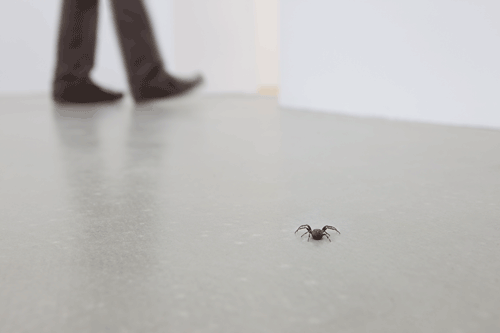Pierre Huyghe
Esther Schipper, Berlin, Germany
Esther Schipper, Berlin, Germany

Ants form close-knit communities which are extremely territorial and defensive. The colony uses scent signals to rapidly communicate the status of potential intruders as friend or foe. Who knows which signal the carpenter ants in Pierre Huyghe’s exhibition ‘Influants’ (Ones who influence) had emitted: War or peace? Relationality or antagonism? The gallery was temporarily taken over by the ants along with house spiders (Umwelt, Environment, all works 2011), an active flu virus (Influenced) and a doorman (Name Announcer), who called out the names of arriving visitors as if they were being received at court (or appearing before a tribunal). According to the press release, the takeover placed ‘the viewer in a situation prompting them to reflect on encounters and influences between visitors and residents […]’.
‘Visitors’ and ‘residents’ could be understood as keywords for gentrification, if one wanted to employ something like site-specificity here. Or were they codes for global points of conflict in general – xenophobia, distribution battles, immigration policy – packaged as a quasi-ephemeral art work? Had Huyghe come up with a new insectoid-viral type of institutional critique? An institutional revaluation of contemporary art as an artistic-scientific laboratory or ‘experimental field‘ (Udo Kittelmann), as exemplified by Carsten Höller’s exhibition ‘Soma’ (2010–11) at the Hamburger Bahnhof? Hardly. ‘Influants’ represented the collector’s nightmare par excellence: live bugs – literal and figurative – multiplying and crawling all over the place. In obvious contrast to his elegant aquarium works (exhibited at the Marian Goodman Gallery in New York in early 2011), these works were never meant to be contained or owned exclusively.
While alluding to many topical events and artistic practices, Huyghe managed – in a perplexingly economical fashion – to bring into play the key themes of his own practice, all in one exhibition: community, ritual, parade, migration, organism, a temporally and spatially open outcome and – drawing on Marcel Broodthaers – what he calls the ‘protocol’ of the exhibition. Transferring the role of protagonist to the insects crawling out of small openings in the gallery walls – not to mention staging a completely unchoreographable virus – was the logical conclusion of Huyghe’s intersubjective trinity: initiation; performers without stage directions and an unforeseeable course of events; and the resulting transitory subjectivities and appearances. One was reminded of earlier projects such as Streamside Day Follies (2004) or the ongoing collaboration ‘No Ghost Just a Shell’, which Huyghe initiated with Philippe Parreno in 1999 around the Manga figure Annlee.
Huyghe repeatedly inverted the territorial-social status quo of that zone called the gallery and the relationship between inside and outside – with the visitor alternating between intruder, guest, virus carrier and prey. Due to the nature of the protagonists in this case, even Huyghe’s rather vague control of the mise en scène was in danger of disintegrating.
Translated by Colin Shepherd
























